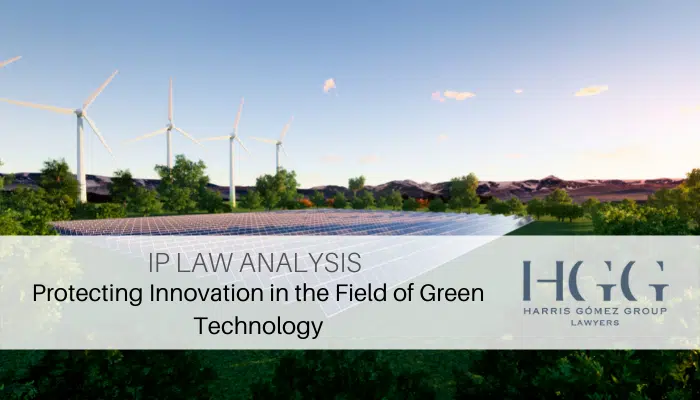Written by Anamaria Correal, Trademark Attorney
Green technology is essential for resolving environmental issues and achieving sustainable development goals. According to EIA it is expected that by 2050 renewables will be the dominant source of world energy, surpassing the share of petroleum, coal, nuclear and natural gas. In addition, different states have now adopted a net-zero climate target which sends a clear signal to green technology investors.
For instance, Australia’s largest state economy NSW has committed to a new target as part of their “Net Zero Plan” that aims to cut emissions in half by 2030, attracting $37 billion in clean energy investment, including low emissions technologies. Furthermore, the world’s largest energy hub, “The Western Green Energy Hub (WGEH)” is a mega scale renewable energy project for WA, that could produce up to 50 gigawatts of wind and solar capacity and will create millions of tonnes of green hydrogen. Moreover, Chile launched its “National Green Energy Strategy” including creating the cheapest green hydrogen on the planet by 2030.
A large number of countries are rising in their attractiveness for renewables investment as illustrated in the EY Renewable Energy Country Attractiveness index, but innovation in green technologies are fundamental to reach climate-neutral goals, and Intellectual Property (IP) plays a critical role in protecting environmentally friendly innovations. This article will explore some alternatives that companies may want to consider for protecting their Green IP.
What are green technologies?
Green technologies are environmentally friendly technologies that help preserve the environment, produce less pollution, and manage resources more sustainably than the technologies for which they were substitutes, as defined by The United Nations Program from Rio of 1992.
How can intellectual property (IP) help sustainability?
IP plays an important role, particularly in protecting green technologies for a sustainable future. You may consider different matters if you want to pursue one or more forms of “Green IP” protection, which include but are not limited to patents, trademarks, trade secrets, copyrights, and designs, amongst others. Nevertheless, this article will focus on patents and trademarks and the Wipo Green.
What are Patents?
A patent is a form of industrial property that may be broadly described as a monopoly right; it includes products and processes which satisfy certain criteria. The protection of patents is territorial, and applicants will be required to disclose their invention. So, if the environmentally friendly invention is protected in country A, it cannot be used without prior consent in that territory; However, the patent needs to be obtained in country B to prevent others from commercially using it. With this in mind, developers should contemplate where the green technologies will be developed and where the potential competitors are.
What are Trademarks?
Trademarks are distinctive signs that show the trade of origin of a product or service. Their protection is territorial and is dependent on registration following formalities and substantive examination by the relevant Trademark Office. Nevertheless, trademarks can be an excellent option to demonstrate that the product is “green”, “eco-friendly” or “sustainable”. While they cannot be descriptive and deceptive, they may be able to include words such as “green” or “eco”. Moreover, if the objective is to demonstrate that the product fulfils certain standards or characteristics, including ‘quality, content, manufacturing method and geographic origin’ a certification trademark may be the right choice.
However, this should be considered on a case-by-case basis. Also, it is fundamental not to use ‘false, misleading, or unsubstantiated claims in relation to the environmental friendliness of products or services or practices’.
What is the WIPO GREEN?
WIPO GREEN is the World Intellectual Property Organization (WIPO) online platform for technology innovation; it has over three thousand eco-friendly technologies in different fields and categories worldwide. It connects key stakeholders and assists in the commercialisation of their products by way of a sale, licence, and joint venture. While technologies or innovations are not required to be patented prior to uploading them into the WIPO GREEN database, careful consideration of your IP strategy needs to be contemplated.
Technologies by categories include but they are not limited to energy, pollution and waste, product, materials, and processes, farming and forestry, water, building and construction, transportation, chemicals, and advanced materials.
Conclusion
Green technologies have attracted a large amount of investment capital around the globe due to the enormous benefits they provide, including protecting the environment, preserving biodiversity, and reducing emissions of carbon dioxide. There is a need to make strategic decisions in protecting your new innovations and environmentally friendly technology by considering different types of IP protection on a case-by-case basis.
Harris Gomez Group opened its doors in 1997 as an Australian legal and commercial firm. In 2001, we expanded our practice to the international market with the establishment of our office in Santiago, Chile. This international expansion meant we could provide an essential bridge for Australian companies with interests and activities in Latin America, and in so doing, became the first Australian law firm with an office in Latin America.
We provide innovative technology and resources businesses with legal and commercial expertise to realise their global potential. Our goal is to see innovative businesses establish and thrive in the global market. We are proud members of Austmine.
To better understand how we can support your management team in the Region, please contact contact@hgomezgroup.com







